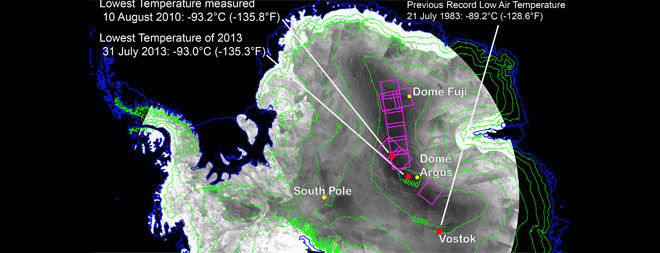The Coldest Natural Place On Earth

Ted Scambos, National Snow and Ice Data Center
(Inside Science) -- According to new measures, the lowest natural temperature on Earth is colder than -136 F. That's more than 93 degrees below zero on the Celsius scale, which is almost as far from the freezing point of water as the boiling point.
"It's in Antarctica, of course," said Ted Scambos, lead scientist at the National Snow and Ice Data Center in Boulder, Colo., at a press briefing on Dec. 9, at a meeting of the American Geophysical Union in San Francisco.
Scambos and a team of researchers reviewed over 30 years of satellite records to reveal the thermal emission temperatures of the ice in Antarctica. These temperatures are like what someone would feel by placing a bare hand directly on the ice, Scambos said. But don't try it. The temperatures can be colder than dry ice.
The team found that the coldest temperatures tended to occur on the southern side of a high ridge, over 13,000 feet above sea level, and between two summits on an ice sheet known as the East Antarctic Plateau.
Why Is It So Cold?
When clear skies last for several winter days, already cold temperatures plummet and the ground radiates its remaining heat into space. The lingering air chills further, making it denser. The cold air then flows along the shallow slope of the ridge. But some of that air can flow into pockets, where cooling continues.
This new temperature is several degrees colder than the current record as listed in the Guinness Book of World Records, which is -128.6 F. This mark was set in 1983 at the Vostok Research Station. The Guinness record, however, is for air temperatures, not the surface temperatures calculated in this study. Scambos suggested that the air temperature on the ridge at the time of the records would have been even colder than that mark, but there was no instrument at the location to measure the air temperature.
Several satellites provided the data for the study, including Landsat 8, which was launched this past February. Just a few months after its launch, during the most recent Antarctic winter, the new satellite marked a temperature just 0.5 F from the 2010 record -- technically, this would be considered "warmer."
When it's that cold, it hurts to breathe. Common mercury thermometers won't work. The snow is so hard, it's loud to walk on, as if you were strolling on crushed glass, said Scambos.
How Low Can Earth’s Temperatures Go?
At this point, scientists don't really know. The temperatures may be constrained by very thin clouds in the stratosphere, which provide some insulation. They may be moderated by relative warmth from the previous summer, preserved a short distance below the surface. But researchers have work to do to find any theoretical minimum temperature.
"There's a complex thermal environment," said Scambos.
Scambos referred to the weather that produced these low temperatures as meteorological freak occurrences. New record-low temperatures may still be recorded, even in a warming world.
And the ridge is much colder than the lowest lows of any other continent. The record low temperature in Alaska is about -80 F. In Siberia the record is -90 F. Humans can survive outside in -100 F temperatures, but only for about 3 minutes, Scambos said.
He noted that these Antarctic winter temperatures of around -135 F are more like what you might see on a nice summer day on Mars.

